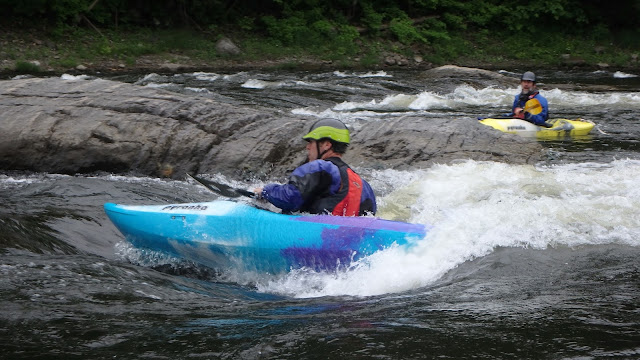Rebecca and I just spent three days taking a whitewater
class in Vermont with Nate Hanson (Pinniped Kayak) and Todd Wright (St.Michaels College Adventure Sports Center) (both of them pictured above). I can still count the number of days I’ve
spent whitewater boating on two hands, but I feel like I’m getting the hang of
it and enjoying it more each time.
Much of my attraction to taking the class was that I didn’t
want to sit through a beginning whitewater class that assumed I would need to
learn a lot of skills that I already had. While there may be more emphasis in
whitewater on certain skills and strokes, they’re basically the same maneuvers
we would do in sea kayaks. With my last blog entry about whitewater for seakayakers, I posted it on some Facebook groups with the question: “do sea
kayaking skills transfer to whitewater kayaking?” and a number of people
weighed-in with opinions in the Facebook comments.
Some of those people had experience in both pursuits – which
seems like a good basis for an educated opinion. In general, those with
experience in both pursuits felt that skills definitely transferred, and those
with a whitewater background tended to assume that sea kayakers might need to
learn the basic sorts of skills that we teach sea kayakers during their first lesson.
I suppose this says more about our notions about either pursuit than anything
else, but after the last three days I can claim with more conviction that both forms
of paddling are parts of the same thing: different boat, different environment,
but most of what you learn in one boat or environment is going to help you in
the other as well. I not only learned about whitewater paddling, but that
experience will help refine my sea kayaking skills.
Everyone in the class had been previously coached in sea
kayaks by both Nate and Todd, and in addition had all spent some time paddling
in tidal currents like Sullivan Falls, so on the first day- Monday on the
Lamoille River, we were able to get out and start having fun right away.
That
day was a ‘park and play’ day, where we used the features in a short stretch to
get a feel for the boats, play around on features and experiment with some of
the maneuvers we would use in tidal currents, like reading the water, ferrying,
surfing, attaining against current and getting efficiently into eddies.
In the
afternoon we worked on safety and group management: rescues, swimming with and
without boats and tossing a throw rope to a swimmer.
One big difference between the two boats is that sea kayaks
maintain momentum pretty well. You can take a couple of good strong strokes
that will propel you well across an eddy zone. But, while whitewater boats can
turn on a dime (which will be super easy if you’re accustomed to turning a sea
kayak) they have the momentum of a potato. And you’ll need to use strokes,
edging and trim to minimize turning. This took some getting used to.
The next two days we did day-long runs on the White River
and the Lamoille. It rained hard for much of Tuesday, so when we returned to
the Lamoille for a longer run on Wednesday, the volume of flow had more than
tripled. It was my first day paddling a whitewater boat in sunshine, and as far
as I can tell it functioned pretty much the same as on a cloudy day.
By then,
we were given a longer leash, striking off on our own to find our own lines and
features, and I think we were all beginning to have more of a sense of
autonomy, like we might be able to get out and do this on our own and have a
sense of what we should or shouldn’t get into.
It’s also worth mentioning that the part about getting to go
down a river amidst some gorgeous scenery is pretty awesome as well. Sometimes
you get a stretch of flatwater where you float/paddle downstream and take a
breather before the next set of rapids, and in those times I marveled at how
sea kayaking had brought me to this beautiful place, via a whitewater kayak. And, as with paddling on the ocean, it brings us to some sublime spots to eat lunch.
I think a lot of sea kayakers who might otherwise enjoy and
benefit from river paddling find the thought of it scary because it’s a little
mysterious, and what we mostly see of it in media are the more sensational
moments, which might involve drops from waterfalls or getting pinned inside a
grabby hole. As with all paddling, there’s always risk, but you can still have
challenges and minimize the risk, and a good way to do that is to start with a
class like this one.












1 comment:
Oh, yea!
Looked like fun.
Post a Comment